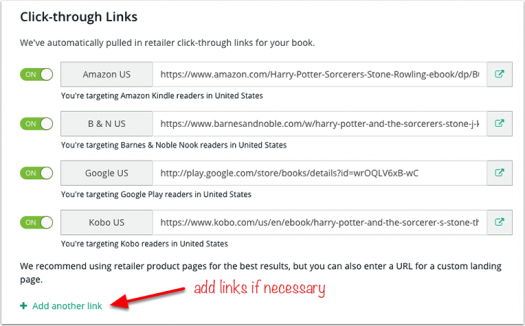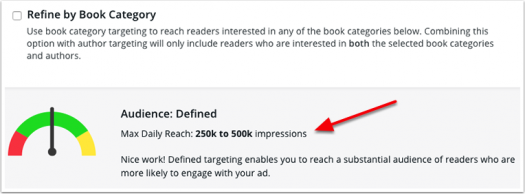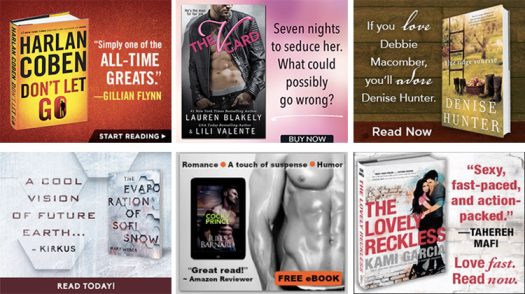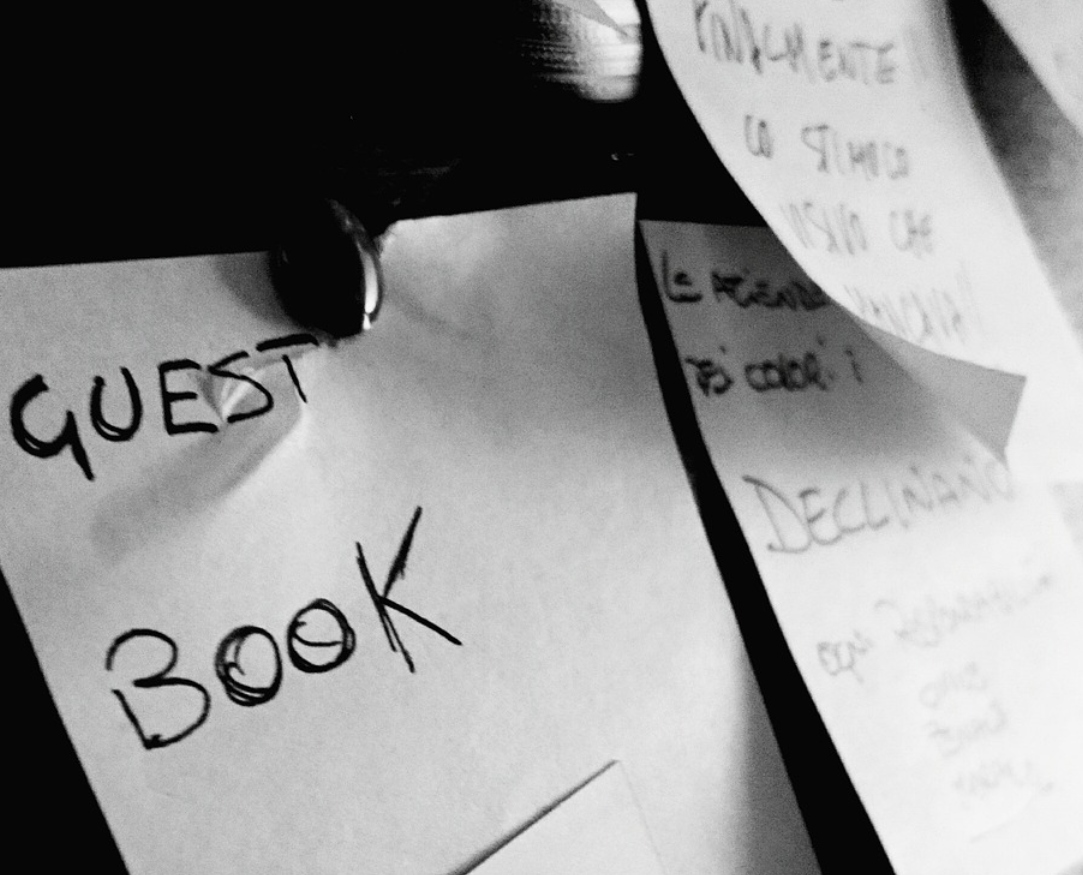How to Increase the ROI of Your BookBub Ads (+ a BookBub Fast Pass)
By Guest | January 22, 2018 |
 Please welcome Diana Urban to Writer Unboxed today!
Please welcome Diana Urban to Writer Unboxed today!
Diana is the Industry Marketing Manager at BookBub, and was previously the Head of Conversion Marketing at HubSpot. She’s an expert in inbound marketing, content marketing, and lead generation.
Diana also recently found the perfect agent for her YA thrillers, Jim McCarthy.
We’re thrilled to have her with us today to explore something she can speak to with much authority, maximizing the ROI of BookBub ads. She has also generously provided a link for WU readers to ‘fast track’ ad applications to BookBub. (Read on to learn more.)
You can learn more about Diana on her website, and by following her on Twitter at @DianaUrban.
How to Increase the Return on Investment of Your BookBub Ads
Many authors are familiar with BookBub’s Featured Deals, the editorially-selected price promotions included in each daily email. BookBub Ads also appear in these emails, but there are several important differences between the two promotional tools. Most notably, you can run BookBub Ads for any book at any time — full-priced books, new releases, novellas, etc. — without needing to go through any editorial review process. The platform is totally self-serve, allowing you to determine your own budget and timeline.
BookBub Ads also offers more nuanced targeting options, allowing you to target readers interested in certain authors, categories, regions, and retailers. In fact, some authors have found BookBub Ads to be one of the most effective ways to reach readers in specific regional/retailer markets (e.g. Kobo Canada).
Advertisers running BookBub Ads campaigns have a variety of marketing goals. These goals often fall into two camps:
- Revenue: Achieve a positive return-on-investment (ROI) by driving clicks and conversions.
- Branding: Increase a book’s exposure by gaining impressions.
It’s important to determine your goal before running a campaign so you can set it up based on what you’re trying to achieve. When running a branding campaign to generate impressions, you might want to accept a negative ROI for the sake of reaping the long-term benefits of exposure. However, when running a revenue-driving campaign to generate clicks and conversions, you’ll be focused on generating a positive ROI so you’re making more than you’re investing.
While every campaign is unique and your specific goals might land somewhere in the middle, we wanted to provide some tips for advertisers specifically looking to boost the ROI of their BookBub Ads campaigns.
Still don’t have access to BookBub Ads? Fill out this form, and we’ll fast-track your invitation! Please make sure you already have a BookBub Partners Dashboard account — if not, you can sign up for one here.
And if you’re ready to create a new ad campaign, you can set one up here!
1. Use CPC bidding instead of CPM bidding
When advertisers run BookBub ads, they can choose between two different bidding strategies: cost-per-click (CPC) or cost-per-thousand-impressions (CPM). With both bidding options, you’re bidding against other advertisers on the platform who are trying to reach the same readers that you’ve targeted with your ad.
With CPM bidding, you choose what you’re willing to pay per 1,000 impressions, where one impression is one opened email. You will win impressions for the audience you’re targeting if you are the highest bidder for that audience.
With CPC bidding, you choose the amount you’d be willing to pay for each click you receive on your ad. CPC bidding is a lower risk to advertisers than CPM bidding because instead of paying for impressions that might turn into clicks, you only pay for actual clicks. For that reason, CPC can be preferable to advertisers seeking a positive return-on-investment.
CPC is also advantageous to advertisers who run effective ads. The higher your click-through rate (CTR), the easier it is to consistently win impressions because the platform will more regularly show ads that readers are actively clicking on.
So if you’re currently running CPM ads and aren’t yielding as high an ROI as you’d like, consider testing CPC bidding instead. Keep in mind that CPC bidding can make it harder to reach as wide an audience — but if you’re prioritizing a positive ROI over a high volume of impressions, this may be a worthwhile tradeoff.
For more details on how this all works, check out the Guide to the BookBub Ads Auction Model.
2. Link directly to the book’s retailer product pages
If you’re currently using a page on your own website as the click-through URL, we recommend testing ads that link directly to a book’s retailer product page instead. This way, you can link readers directly to their preferred retailer, reducing the number of clicks required to purchase the book, which could have a positive impact on the ad’s ROI.
Linking readers to their preferred retailer is super easy! Just be sure to select the book you’re promoting when creating a new ad:

BookBub will automatically pull in the book’s retailer links. Your ad will automatically target readers in the relevant regions and link them to their preferred retailer in order to maximize the ad’s conversions to sale. You can edit or add additional retailer links if necessary.

3. Refine your targeting
If your ad’s CTR is low and you’re not getting a high ROI, you may be targeting too broad an audience. Consider refining your targeting by using author targeting. This will allow you to reach readers who have expressed interest in specific authors, and will likely help you reach a smaller, more relevant audience. Include yourself (or the author of the book you’re promoting) and other authors who have written books similar to the one you’re promoting.

Also note that by using both category and author targeting, you’ll only reach readers who are interested in at least one of the selected book categories and one of the selected authors. This can help narrow your target audience even further.
As you adjust your targeting, keep an eye on the audience dial at the bottom of the page, which will update to indicate your estimated maximum daily reach based on your targeting.

4. Optimize your creative
If you’re not getting enough clicks, it could mean that your ad design isn’t engaging enough. Here are some best practices that have been effective for advertisers:
- Include a book cover image. Testing has shown that ads featuring an image of the book’s cover get more clicks than ads without a cover.
- Make the text easy to read. Your text should be actionable and large enough to read.
- Use a short quote or blurb. Ads including a quote or blurb from a big-name author or publication have above-average click-through rates.
- Include a call-to-action button. Give viewers a final nudge by including a call-to-action button they can click. Use contrasting colors to make the button stand out in the design.
Here are just a few examples:

Like everything else in publishing, ad creative can be highly subjective, and best practices and trending tropes can differ by genre. Testing your ad designs can help determine what works best for a particular book and its unique audience.
5. Run A/B tests
Running an A/B test is a great way to figure out which targeting and/or creative can get you as high a CTR as possible. Essentially, you’ll run two different ads simultaneously and compare the CTR for each. The variation with the highest CTR is the winner.
To run an A/B test on BookBub Ads, create two ads with identical settings except for one element. Once you create your first ad, save it as a draft, then duplicate it by clicking the copy icon. This will let you carry over all your settings from the first ad:

For example, if you’re testing different designs, you could test whether including a blurb in the creative drives more clicks than a short synopsis, or whether including the price point in the ad generates more clicks than leaving the price out. Or if you’re testing different targeting options, use the same creative in each ad, but target readers interested in a different author.
See step-by-step instructions for A/B testing creative using BookBub Ads here.
A/B testing is a great way to find what combination of targeting and creative works best for you without burning through your marketing budget. We recommend running several test campaigns with low budgets ($10-20), determining the winners, and then increasing the budgets of the winning variations.
If you have questions about the BookBub Ads platform, feel free to ask Diana your questions in the comments below. If you ever have questions about your own Ads campaigns, email partners@bookbub.com to get advice from a BookBub account representative any time.
And as a reminder, if you still don’t have access to BookBub Ads, you can fill out this form, and we’ll fast-track your invitation!










Just got approved a few weeks back and intend to make good use of this article. THANKS Diana Urban!!
Hi Kellie! That’s wonderful, and I’m so glad you found this article helpful! :-)
I’ve done several BookBub promotions for my three supernatural mystery novels and have a mix of good results and not so good results. I’ve not tried ads at Bookbub yet but have been considering the pros and cons of your advertising programs. I’ve actually been doing some ads with Amazon Marketing for my novels at full price. Diane, can you give us some comparison points on why BookBub ads might be better than doing Amazon ads? That would be helpful.
Hi Paula! Great question. Some things we’ve heard our advertisers love about BookBub Ads are:
– BookBub’s audience is entirely made up of readers, so you know you’re reaching people looking for books.
– It’s really easy to target Ads by retailer and region — many BookBub advertisers use Ads to engage readers they find harder to reach elsewhere.
– Targeting your own fans (by including your name in the “author targeting” section) lets you reach readers who’ve clicked on your BookBub Featured Deals, so it’s a great way to drive interested readers towards the next book in your series or upsell them on another full priced title.
– Our reporting updates every hour, so you can get near-real-time click data and optimize your ads accordingly.
Hope that helps! If you’d like any advice getting started with BookBub Ads, please feel free to email partners@bookbub.com, and one of our account representatives would be happy to help.
Diane, thanks for the opportunity to ask someone like you the right questions.
I write mainstream fiction – indie.
It means my target audience is the readers who will buy ebooks (and print, but that’s not my first focus) from traditional publishers at full price.
I’ve tried Amazon ads, but I’m pretty sure the readers who would enjoy my work find their books through such venues as NPR and recommendations from book bloggers who don’t read self-published work. Ever.
Catch 22.
Any specific suggestions for someone like me, out in left field even in indie (where most work is genre, not literary/mainstream/big book) via BookBub ads?
It’s not the expenditure – paying for advertising isn’t the problem if it gets results – it’s overcoming obscurity.
Thanks!
PS For reasons I won’t go into, I have extremely little energy, and it’s going into writing the next two books of the trilogy, where it must.
Hi Alicia, thanks for your interest in BookBub Ads! I’m happy to answer any questions about the platform here. If you’d like more personalized advice, one of our account representatives would be happy to answer specific questions regarding your marketing strategy. Please feel free to email partners@bookbub.com any time. :-)
Thank you for an interesting look inside the industry’s foremost ebook marketer! I have one quick question. The ads seem much smaller and harder to locate than the promos. Is there anything in the works to address this issue?
Hi Linda. You’re welcome, I’m so glad you found this article helpful! As for BookBub Ads’ placement — we did a ton of testing to ensure our advertisers would see great results from their campaigns without the ads affecting the performance of the Featured Deals. At this time we don’t have plans to place the ads elsewhere in the emails, but it’s great feedback, and I’ve passed it along to the team. :-)
Is it possible to see some actual results of these ads? These are missing in the article kinda… it’s great to learn about these ads but at the same time, people need to see success stories. It’s not just inspiring but also proof.
Definitely a fan of BB and if these ads work well, it’s super cool – another advertising channel for indies along with Facebook and Amazon ads. Fingers crossed for that! But do show us some real results.